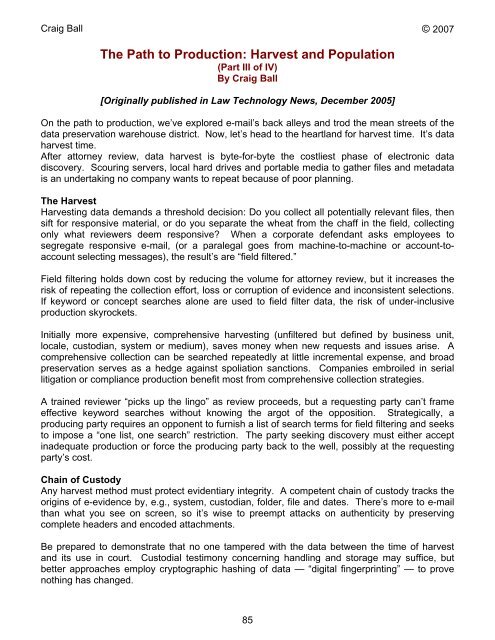Six Articles on Electronic - Craig Ball
Six Articles on Electronic - Craig Ball
Six Articles on Electronic - Craig Ball
You also want an ePaper? Increase the reach of your titles
YUMPU automatically turns print PDFs into web optimized ePapers that Google loves.
<strong>Craig</strong> <strong>Ball</strong> © 2007<br />
The Path to Producti<strong>on</strong>: Harvest and Populati<strong>on</strong><br />
(Part III of IV)<br />
By <strong>Craig</strong> <strong>Ball</strong><br />
[Originally published in Law Technology News, December 2005]<br />
On the path to producti<strong>on</strong>, we’ve explored e-mail’s back alleys and trod the mean streets of the<br />
data preservati<strong>on</strong> warehouse district. Now, let’s head to the heartland for harvest time. It’s data<br />
harvest time.<br />
After attorney review, data harvest is byte-for-byte the costliest phase of electr<strong>on</strong>ic data<br />
discovery. Scouring servers, local hard drives and portable media to gather files and metadata<br />
is an undertaking no company wants to repeat because of poor planning.<br />
The Harvest<br />
Harvesting data demands a threshold decisi<strong>on</strong>: Do you collect all potentially relevant files, then<br />
sift for resp<strong>on</strong>sive material, or do you separate the wheat from the chaff in the field, collecting<br />
<strong>on</strong>ly what reviewers deem resp<strong>on</strong>sive? When a corporate defendant asks employees to<br />
segregate resp<strong>on</strong>sive e-mail, (or a paralegal goes from machine-to-machine or account-toaccount<br />
selecting messages), the result’s are “field filtered.”<br />
Field filtering holds down cost by reducing the volume for attorney review, but it increases the<br />
risk of repeating the collecti<strong>on</strong> effort, loss or corrupti<strong>on</strong> of evidence and inc<strong>on</strong>sistent selecti<strong>on</strong>s.<br />
If keyword or c<strong>on</strong>cept searches al<strong>on</strong>e are used to field filter data, the risk of under-inclusive<br />
producti<strong>on</strong> skyrockets.<br />
Initially more expensive, comprehensive harvesting (unfiltered but defined by business unit,<br />
locale, custodian, system or medium), saves m<strong>on</strong>ey when new requests and issues arise. A<br />
comprehensive collecti<strong>on</strong> can be searched repeatedly at little incremental expense, and broad<br />
preservati<strong>on</strong> serves as a hedge against spoliati<strong>on</strong> sancti<strong>on</strong>s. Companies embroiled in serial<br />
litigati<strong>on</strong> or compliance producti<strong>on</strong> benefit most from comprehensive collecti<strong>on</strong> strategies.<br />
A trained reviewer “picks up the lingo” as review proceeds, but a requesting party can’t frame<br />
effective keyword searches without knowing the argot of the oppositi<strong>on</strong>. Strategically, a<br />
producing party requires an opp<strong>on</strong>ent to furnish a list of search terms for field filtering and seeks<br />
to impose a “<strong>on</strong>e list, <strong>on</strong>e search” restricti<strong>on</strong>. The party seeking discovery must either accept<br />
inadequate producti<strong>on</strong> or force the producing party back to the well, possibly at the requesting<br />
party’s cost.<br />
Chain of Custody<br />
Any harvest method must protect evidentiary integrity. A competent chain of custody tracks the<br />
origins of e-evidence by, e.g., system, custodian, folder, file and dates. There’s more to e-mail<br />
than what you see <strong>on</strong> screen, so it’s wise to preempt attacks <strong>on</strong> authenticity by preserving<br />
complete headers and encoded attachments.<br />
Be prepared to dem<strong>on</strong>strate that no <strong>on</strong>e tampered with the data between the time of harvest<br />
and its use in court. Custodial testim<strong>on</strong>y c<strong>on</strong>cerning handling and storage may suffice, but<br />
better approaches employ cryptographic hashing of data — “digital fingerprinting” — to prove<br />
nothing has changed.<br />
85













